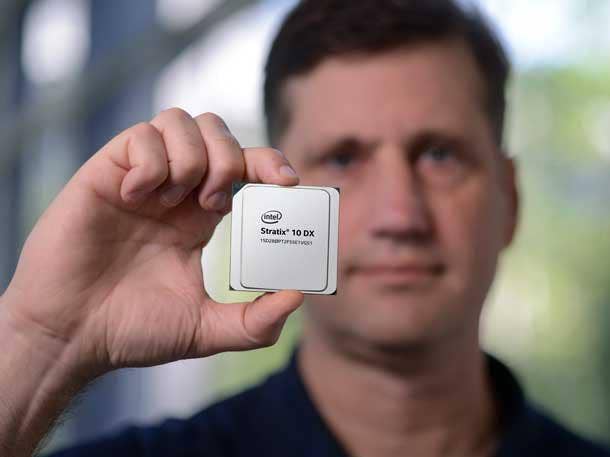Intel's New Stratix 10 DX Works With Optane, Xeon To Speed Up Workloads
'We're able to share the memory space coherently between the FPGA and processor, expanding memory available to the application,' Intel exec Patrick Dorsey said of the chipmaker's new programmable chip for edge, networking and data center applications.

Intel is demonstrating the strengths of its data-centric platform strategy with the new Stratix 10 DX FPGA, a reprogrammable chip that works in tandem with Optane DC persistent memory and future Xeon Scalable processors to expand system memory and accelerate data-intensive workloads.
The Santa Clara, Calif.-based company Thursday unveiled the new field-programmable gate array product, an extension of Intel's Stratix 10 FPGA line that the chipmaker said will "dramatically increase bandwidth" and offload certain tasks from Xeon processors to improve data center efficiency.
[Related: Intel Gets FPGA Win As Dell EMC, Fujitsu Adopt Reprogrammable Chips For Their Server Lineups]
The Stratix 10 DX, which is now available for engineering samples, is the first FPGA to support Intel's Ultra Path Interconnect technology, according to Patrick Dorsey, vice president and general manager of product marketing in Intel's Networking and Custom Logic Group. That's significant because it allows the FPGA to share memory from Intel's Optane DC persistent memory dual in-line memory module with select Xeon Scalable processors or any of its cores or any virtual machines running on those cores.
"We're able to share the memory space coherently between the FPGA and processor, expanding memory available to the application," Dorsey said, adding that the chip, along with new Intel developer tools, will enable the building of applications that can leverage new coherent memory capabilities.
This expansion of memory can accelerate workloads running larger data sets, which can benefit data centers as well as edge applications, according to Dorsey. Intel's Ultra Path Interconnect, or UPI, can also lower latency in edge applications that require real-time responses. In addition, The Stratix 10 DX supports PCIe 4.0 connectivity, which doubles the available bandwidth for applications compared to the third, current generation of PCIe.
VMware is among the early adopters of the Stratix 10 DX, which VMware executive Krish Prasad said is part of a "long history" VMware and Intel have of "delivering innovation solutions to the industry."
"As part of this continued partnership, VMware is collaborating with Intel to develop coherent FPGA and CPU acceleration solutions," said Prasad, senior vice president and general manager of VMware's Cloud Platform Business Unit, in a statement. "Our mutual customers demand high performing, easy to use, and reliable infrastructure, both on-premises and in the cloud."
Dorsey said Intel's FPGA product roadmap includes support for PCIe 5.0 and Compute Express Link, or CXL, a new high-speed CPU-to-device and CPU-to-memory interconnect under development by Intel that is gaining widespread support from industry players, including AMD, Dell EMC and Microsoft.
"We see UPI as the starting point for CXL applications," Dorsey said.
The Stratix 10 DX enters production later this year.